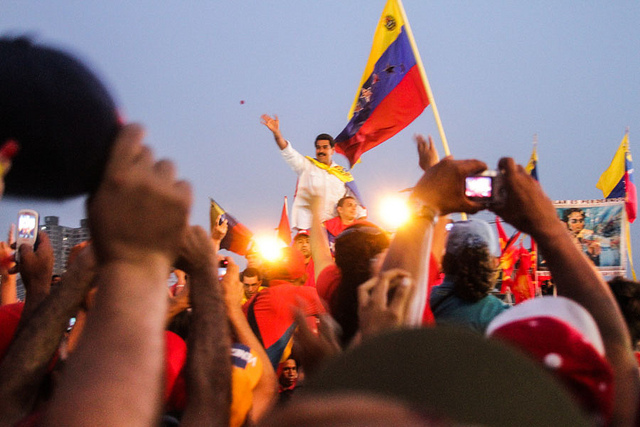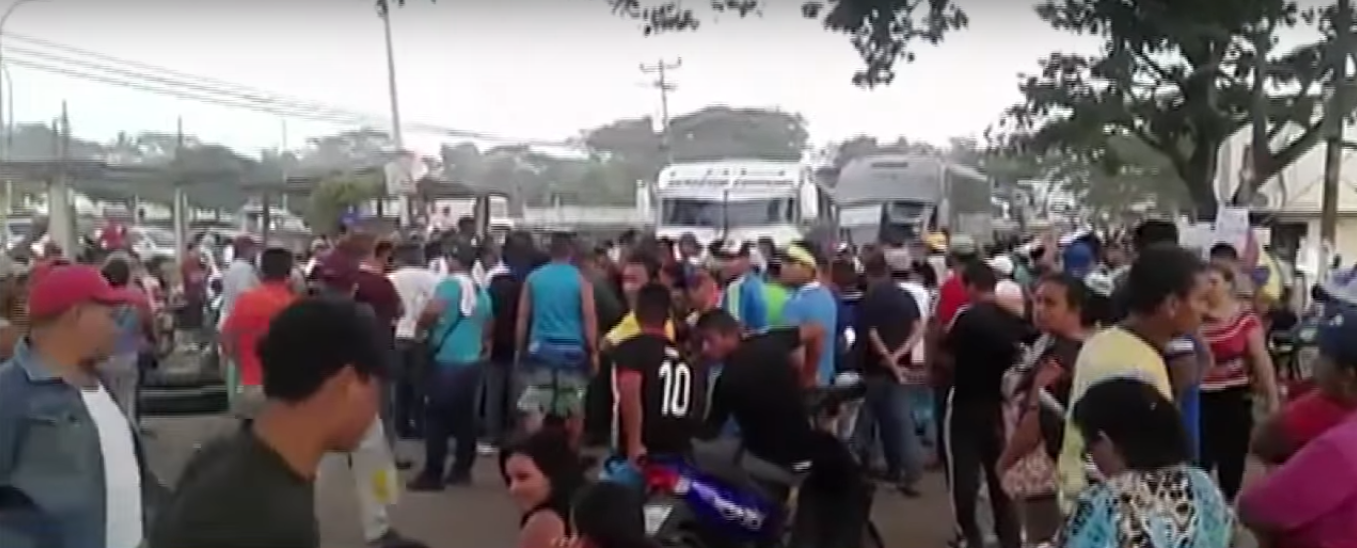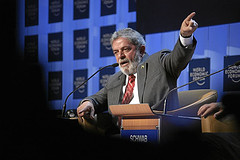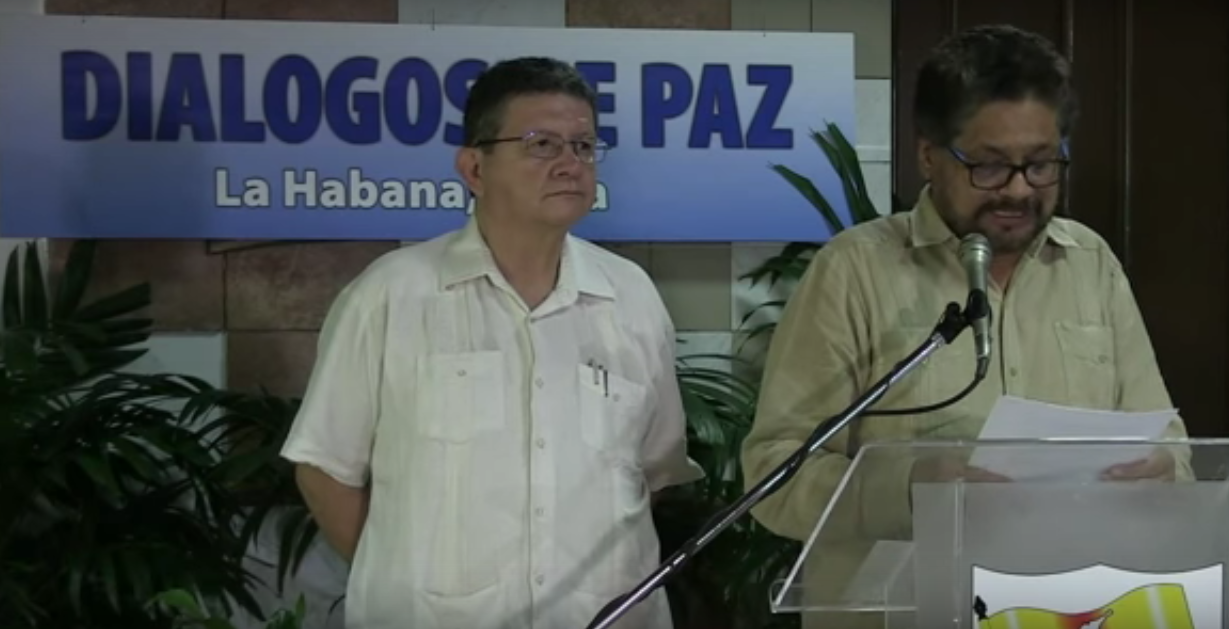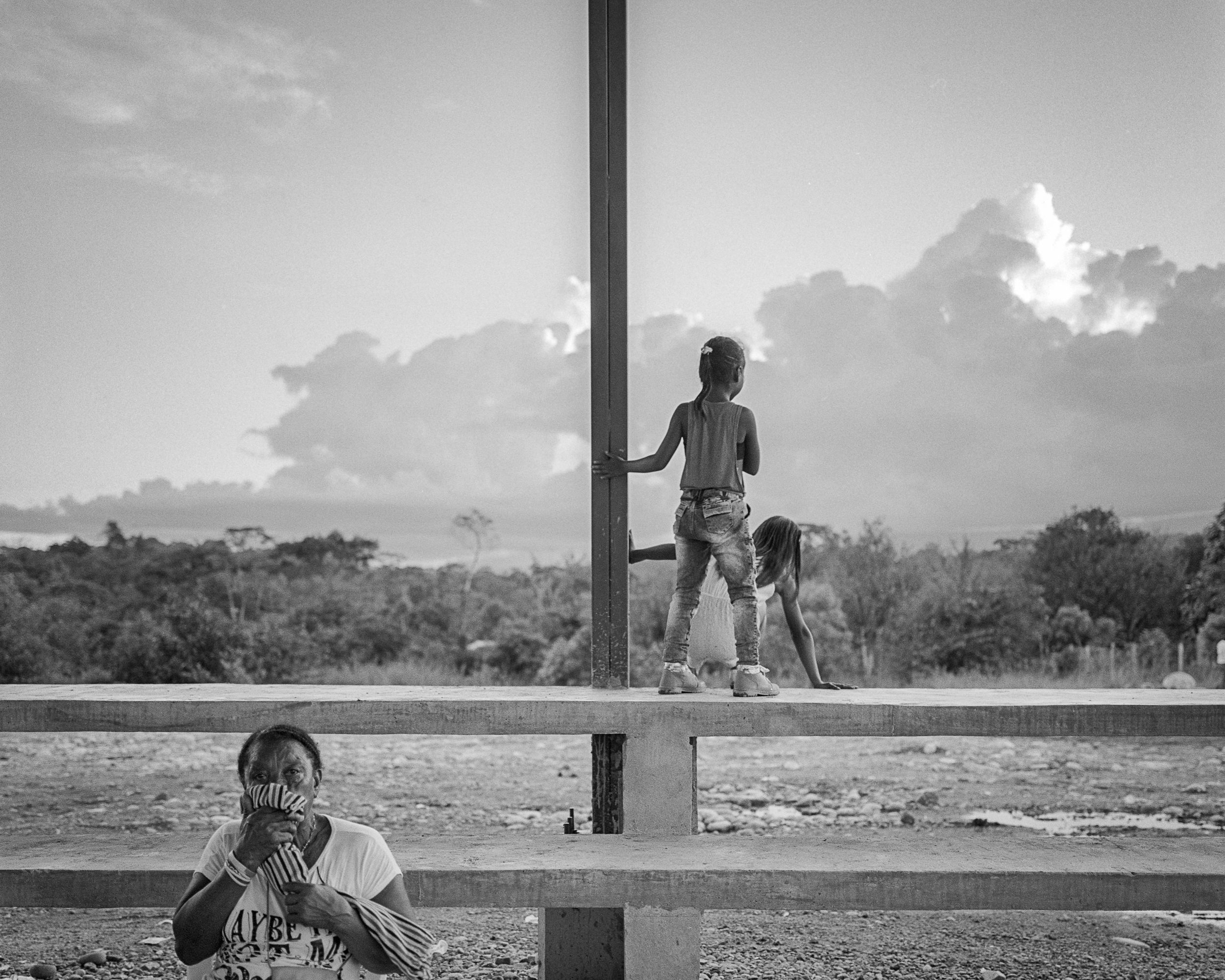
Andes, Colombia, Dispatches, Features
Colombia’s Coca Substitution Plan is Bringing Death and Discord to the Putumayo Region
January 10, 2019 By Steven Cohen
This article was originally reported for and published in Spanish in La Liga Contra el Silencio. It was translated into English by the author. View the Spanish version here.
Last July 20, Colombian Independence Day, José Oswaldo Taquez called a meeting in the three-room schoolhouse in El Remolino, a small, coca-growing hamlet in the southern Putumayo province, along the border with Ecuador. Despite their reservations, many residents had signed up for a nationwide program that aims to substitute coca, the plant precursor to crystal cocaine, for other, legal crops. Participating families had already begun pulling up their coca bushes, but none of the incentives outlined in the 2016 peace agreement with the Revolutionary Armed Forces of Colombia (FARC) had yet arrived—not the first of twelve monthly subsidies, nor the subsistence vegetable gardens, much less the technical assistance for their alternative development projects. With each passing day, anxiety about the process grew.
Pamphlets had been circulating through the region in recent months, threatening local leaders and announcing a new campaign of “social cleansing.” There had also been talk of new armed groups occupying former rebel territory. Displaced almost in its entirety by United Self Defense Forces of Colombia (AUC) paramilitaries in the early 2000s, El Remolino was only just recovering its sense of community. Maybe that’s why residents tried to convince themselves that there was no real danger behind the rumors. But for Taquez, one of the few who stayed throughout the whole paramilitary period, it was not so easy to simply ignore the threats. If anyone was at risk, it was him.
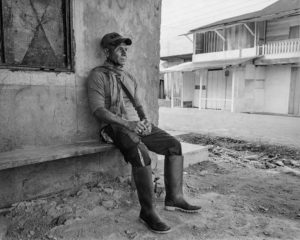
Tobías is 50 years old and is a coca harvester. He is originally from Riacurte, Nariño, but every year he goes job hunting in the region of Piedemonte in Putumayo. He gets paid 6,000 Colombian pesos (or $1.85) for every bushel of coca leaf harvested. | Photo: Miguel Winograd
As president of El Remolino’s Community Action Council, Taquez had taken it upon himself to promote substitution in the hamlet. The pamphlets didn’t mention him by name, but there were families who, because of their hostility toward the program, had labelled him a “snitch.” His loved ones worriedly followed national news about the extermination of social leaders, and Taquez himself sought protective measures through the ombudsman’s office in the distant county seat of Orito. Thinking of his family and his 51 years of age, he had already decided to resign his leadership position when he held the meeting that July afternoon.
The idea was to calm the situation. Taquez clarified that he wasn’t forcing anyone to do anything, that those who had joined the substitution program did so of their own accord. Forced eradication was coming, yes, but not because he had invited it. To those who preferred to take their chances, Taquez wished the best of luck. He took a while answering questions, explaining how the first monthly payment, scheduled for the following Monday, would work. An hour and a half before sundown, he mounted his horse and started down the trail to his house, which borders a neighboring hamlet. Taquez never arrived. His body was found that night riddled with bullets, about 300 feet from the door.
The FARC peace process brought a brief respite to Putumayo, which had for years been an epicenter of Colombia’s escalating armed conflict. Virtually all indicators of violence dropped, and weary campesinos throughout the region began to hope that the broad reforms outlined in the FARC agreement would translate into much-needed change. Foremost among those reforms was coca substitution, a program designed to help farmers make the switch to alternative agricultural economies. Long one of the country’s leading coca producers, Putumayo has advanced further with substitution—both in acres eradicated and participating families—than any other department. But while the program was supposed to create new opportunities for sustainable development, it has also destabilized an already precarious “post-conflict” transition, exposing the department’s most vulnerable communities to new risks and perils.
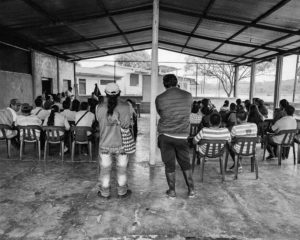
Meeting of peasant, Afro-colombian and indigenous communities from Jardines de Sucumbíos, and members of the Fundaprogreso Foundation. Its members discuss crop substitution programs and the safety in the region. | Photo: Miguel Winograd
Taquez was the second leader of El Remolino to be murdered in the past two decades. And just as had happened years before, this past summer the Community Action Committee was buried along with its president. “We can’t depend on any institutional support,” said one former member, who asked not to be identified for fear of reprisals. “It’s better to leave it be.” That lack of confidence in organizing processes extends into basic daily interactions. “Everyone is scared to talk, because you don’t know who is listening,” said a person close to Taquez, who declined to be interviewed in front of their neighbors but communicated with La Liga Contra el Silencio later by phone. “If it was someone from the community, then they could be right there. And if it was the guerrilla or the mafia, then that means that they had someone working as an informant.”
La Liga visited El Remolino in August, during a meeting with officials from Families in Their Territory, a government initiative to facilitate the return of forcibly displaced persons. Perceptible amid the nervous silences were indications of the social decomposition currently being experienced throughout the entire Bajo Putumayo. Death threats and targeted violence have increased in the region. As of November, local human rights groups had registered the killings of at least 13 social leaders in the previous 12 months. The Fundación Ideas para la Paz (FIP), a national conflict research group, determined that, between 2017 and 2018, 41 protected persons were murdered.
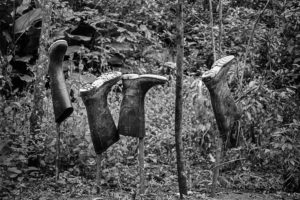
Rubber boots are what peasants characteristically use when they work in the fields and go into the bush. | Photo: Miguel Winograd
Crop substitution is not necessarily the direct cause of this situation. “Putumayo concentrated many of the vulnerability and risk factors that we have identified,” explains Irina Cuesta, a FIP researcher. Significant among them are historical land conflictivity, high levels of poverty, and the lack of investment in healthcare, education, infrastructure, and social welfare in general.
In a region where coca has constituted the fundamental axis of economic, political, and even cultural development, the change implied by substitution has created a context of uncertainty that brings concrete consequences for organizing processes—precisely in a moment that demands unity.
“It seems like everything is up in the air, when what we most need are guarantees to be able to continue our work in the promotion of peace,” Janeth Rita Silva, a leader of the Perla Amazónica Campesino Reserve Area, said in July. The following month, Silva would go on to suffer threats and harassment. In October, Otto Valenzuela, another leader in Perla Amazónica, would be murdered. But even well before then, Silva sensed that the situation was deteriorating. “We are in a very, very complicated moment,” she said.
Thanks in part to the only regional pre-agreement, substitution in Putumayo has vastly outperformed its counterparts in other coca-producing regions. In 2017, the national substitution office selected the area surrounding the La Carmelita demobilization camp as one of six pilot sites for the program. After a lengthy rollout process, 20,000 familias signed up, of which 13,000 are cultivators. (The remaining 7,000 are either harvesters or work in some other aspect of production.) So far this year, the United Nations Office on Drugs and Crime has verified the “voluntary” eradication of 8,686 of the almost 30,000 hectares it detected in 2017. Putumayo alone represents 28 percent of the all the coca crops eradicated in the country. “Historic figures,” emphasized Aldemar Yandar, the program’s regional coordinator. “All previous efforts are band-aids relative to the scale of this one.”
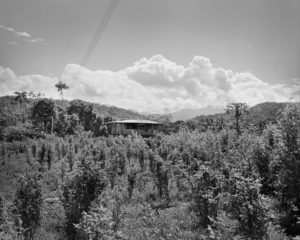
House surrounded by coca crops, located in the region of Piedemonte, Putumayo. | Photo: Miguel Winograd
The current substitution program has had various antecedents in Putumayo, and since 1997, Yandar has assisted all of them. From his perspective, the FARC peace agreement corrected many past errors. While it’s not “loaded with cash,” as some coca farmers seem to believe, the substitution office does have enough budget to make good on its existing commitments, something that has not always been the case previously. In the place of unaccountable foreign NGOs, local operators, selected by the communities themselves, will administer technical assistance resources. Yandar insists that the supports and oversight mechanisms established in the peace agreement allow the program to enjoy long-term sustainability. Above all, he points to the cooperation of the FARC, who for many years prevented the possibility of any serious attempt at substitution. “Given that the guerrilla did not allow us to enter areas of high coca production, we had to make do with hamlets close to town centers, where there is less,” laments Yander. “This time we have actually reached the heart of coca production.”
According to conventional anti-drug wisdom, the more acres of coca the government eradicates, the better the conditions of security should become. But in the rural areas of Putumayo, the exact opposite is happening. “The issue of security is transversal to the program, but up until now it hasn’t been established,” recognizes Edinson Ramírez, Orito’s secretary of government. “The perception of insecurity has augmented.”
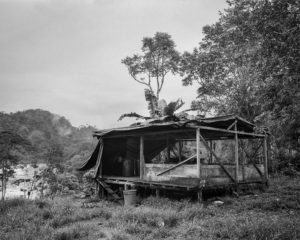
A laboratory in the low region of Putumayo where the coca leaf is processed to produce cocaine base paste. | Photo: Miguel Winograd
Beyond the figures, it is that perception that has both public officials and grassroots leaders worried. “We have visited areas where people are living panicked,” said Ever Castro, a threatened leader from the border county of San Miguel. “They’re scared, they don’t want to say anything.” Local media have themselves been the target of a growing intimidation campaign, and public security forces, instead of resolving these fears, often end up multiplying them. “No one explains the why,” says Castro. “If we ask the police they come back to us with, ‘No, it was a business deal gone wrong. No, maybe it had to do with the mafia. No, it was just a wife getting jealous over her husband.’”
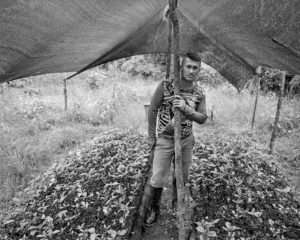
Hugo Ordoñez Bravo in his nursery of pink bourbon coffee plants, a crop projected to substitute coca in Jardines de Sucumbíos. | Photo: Miguel Winograd
Amid auto-censorship and judicial impunity, disinformation prospers. In dozens of interviews with coca-growing peasant farmers, La Liga heard falsehoods and wrong interpretations, many of them small, but some with important implications for the substitution process. There are those who think, for example, that the peace agreement prohibits forced eradication, when in reality it reinforces the government’s right to perform it.
Particularly distressing for leaders is the apparently widespread misconception that they are the ones who decide whether a given family has violated the terms of the substitution agreement. Castro registered for the program, because, as a human rights defender, “the government authorities always have their eye on you.” None of the other 27 familias in Las Lomas, his hamlet, which borders one where a substitution leader was killed in August, signed agreements. Now, “people from my own community think that I’m their enemy. They say they’re going to get eradicated because of me.”
Adelaida Orozco, an Afro-indigenous leader from Valle del Guamuéz and victim of sexual violence at the hands of both the FARC and the AUC, fears that “the dischord, the disputes” that substitution has generated could eventually lead to an even more pernicious dynamic than that of the armed conflict. In her organizing work with the feminist Ruta Pacífica de las Mujeres network, Orozco notes a lamentable change in mentality. People don’t show solidarity as readily as when they were surrounded by the conflict. “Today, everything is worse than before,” she insists. “There’s nothing but mistrust between people.”
Nurtured by that mistrust and by an extensive, varied illicit economy, new armed structures are inserting themselves into the post-conflict power vacuums. “When the peace process started, you felt a lot of tranquility, a lot of calm,” says Fernando Palacios, the mayor of Valle del Guamuéz. “But because the national government didn’t occupy those territories, others took advantage of these spaces.” So-called criminal bands like La Constru, which used to negotiate the intermediary purchase of cocaine “base paste” with the rebels, did not delay in reconfiguring the drug trade. At the same time, dissident factions of the FARC’s 48th and 32nd Fronts have expanded. Within their ranks are numerous ex-combatants who, disillusioned with the killing of their former comrades or the government’s manifest disregard for certain aspects of reincorporation procedure, have left the demobilization zone in Puerto Asís.
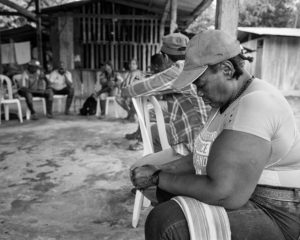
Meeting of the Afro-colombian communitary council Nuevo Renacer in Jardines de Sucumbíos. | Photo: Miguel Winograd
During the initial months of the peace process, the military acted quickly to effect patrols over previously inaccessible territories. But as some commanders admitted to La Liga, they lack troops and resources to maintain effective vigilance over remote communities in the Amazonian piedemont. Under the stewardship of Guillermo Rivera, the first national government minister from Putumayo, the Santos administration’s Interior Ministry not only left Putumayo without an integral security plan for the post-conflict, as called for by the FARC agreement; it did not even send representatives to participatory regional security meetings.
“We as leaders are totally abandoned, our people left to the mercy of whichever group,” said José Maya, president of the Orito’s association of community action committees, to which Oswaldo Taquez belonged. “The people are right,” said Yandar, the substitution coordinator. “We worry alot about their security, our own security.”
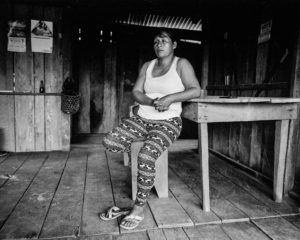
María Dolores Acanamejoy, president of the Community Action Council of the Vereda Alto Amarradero in Jardines de Sucumbíos. | Photo: Miguel Winograd
The emerging security panorama painted from above by experts and authorities does not always align with the perspectives of those living in the most affected territories. “Here there is not one group, but many,” said Roberth Guillermo Pinta, a human rights defender and displaced substitution leader from San Miguel. It is often said that alias “Sinaloa,” the commander of a dissident FARC group, controls that area. But the situation Pinta describes is significantly worse: an abundance of tiny armies and mafias, each one following its own rules. “Some say one thing and others say another. So we don’t know who to listen to,” said Pinta. “You can’t dialogue with these people.”
For many communities, though, dialogue is an obligation imposed by force. In Jardines de Sucumbíos—a village that technically belongs to Ipiales, Nariño province, whose administrative head is 15 hours away—the months following the FARC’s demobilization saw a series of robberies, muggings, and abuses committed by youths aspiring to form a gang. According to various residents, community leaders and authorities, the situation continued to worsen until the arrival of another group, which in mandatory community meetings called itself a “revolutionary mafia.” This group wasted little time in imposing its law. Alleged thieves, drug addicts, all manner of “delinquents” were warned, according to people who attended the meetings. Whoever didn’t leave town were killed, including in a massacre documented at the local police inspection archives.
This type of “mano dura” justice perpetrated by the new armed groups is not new to Putumayo, and in Jardines de Sucumbíos there are those who openly prefer it to the chaos they perceived after the FARC’s demobilization. But leaders recognize that behind the social approbation are looming unresolved questions. “They haven’t done any harm here,” said María Dolores Acanamejoy, a member of the Kamentá people and president of the hamlet of Alto Amarradero. “They’ve even said to people, ‘Let’s get together and improve the roads,” a need she herself has insisted on. However, it concerns Acanamejoy that, from one day to another, the group might decide to stop accepting the hamlet’s established norms or decide to impose some of its own. “What happens if substitution fails, like before? Who will the people blame? Or if it works, but there are those who weren’t able to join?
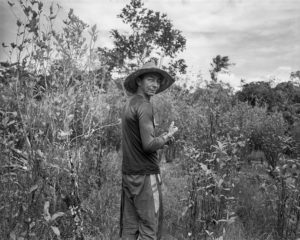
Eduard de Jesús Velásquez, known as “Chamizo” and husband of María Acanamejoy, in a coca crop that was later voluntarily eradicated. | Photo: Miguel Winograd
Acanamejoy was suspended from the program, according to her due to a few unkempt bushes that she had yet to pull up when the UN inspectors came to her farm. She says that there had been much confusion about a forced eradication that was supposed to take place in the days prior to the UN’s visit, a rumor the community did not report because it didn’t want to draw undue attention. However, like almost all the leaders interviewed for this report, has decided to continue forging ahead with substitution, which after all is a program that she has spent years fighting for. While she and her husband wait to see whether they will be allowed to re-enter the program, they are sewing pineapple and rice in the plots where they used to have their coca plants. “Even if the government doesn’t honor their part, we are going to demonstrate that we do have the will to change things.”
Since the transfer of power in August, President Iván Duque’s administration has given contradictory indications about its intents regarding substitution. But the hardline posture the president assumed on his recent “prohibitionist tour” of the United States has consequences, even if it doesn’t manifest in new policies. Duque may not answer the calls, emanating from his own right-wing Democratic Center party, to bring back the much-hated aerial coca spraying program. But in Putumayo the mere proposal of fumigation begs new questions of a process that already has too many. “What we as coca-growers need are guarantees, a serious, dependable commitment,” said Yuli Zuluaga, a Putumayo representative of the National Committee of Coca, Poppy, and Marijuana Growers. “Because of their experiences with the government, people here are just waiting for the program to fail again like always.”
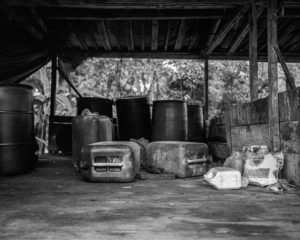
Barrels and cans storing substances used to process the coca leaf and produce the base paste of cocaine in the Bajo Putumayo. | Photo: Miguel Winograd
Luz María Ataques, a friend of Oswaldo Taquez, wakes up every day with memories of what happened the last time the government mounted “a frontal attack on narcotrafficking” in Putumayo, like the one President Duque has proposed. In 2000—when Plan Colombia began in the region, and with it, the massacres and fumigations—paramilitaries disappeared her husband, dismembering his body. Years later, those same paramilitaries entered El Remolino and raped Ataques in front of one of her three children.

Uprooted coca plant, part of the voluntary manual eradication program in the Putumayo Piedemonte. | Photo: Miguel Winograd
Few are the residents of this hamlet who do not have a story marked by acts of extreme violence, and many those who, like Ataques and her children, continue to await indemnization from the government. It is because of this unresolved collective trauma that Taquez’s murder inspired such fear about the future. “It makes you think of everything that took place before,” said Ataques. “For us, who have suffered so much, it’s difficult not to imagine that it could happen again.”
About Steven Cohen
Steven is a journalist, fact-checker, and researcher from Washington, DC, pursuing a master’s degree in journalism and Latin American and Caribbean studies. His reporting has appeared in BBC, The Nation, Christian Science Monitor, and The New Republic, where he worked as a fellow.
Next Article >
